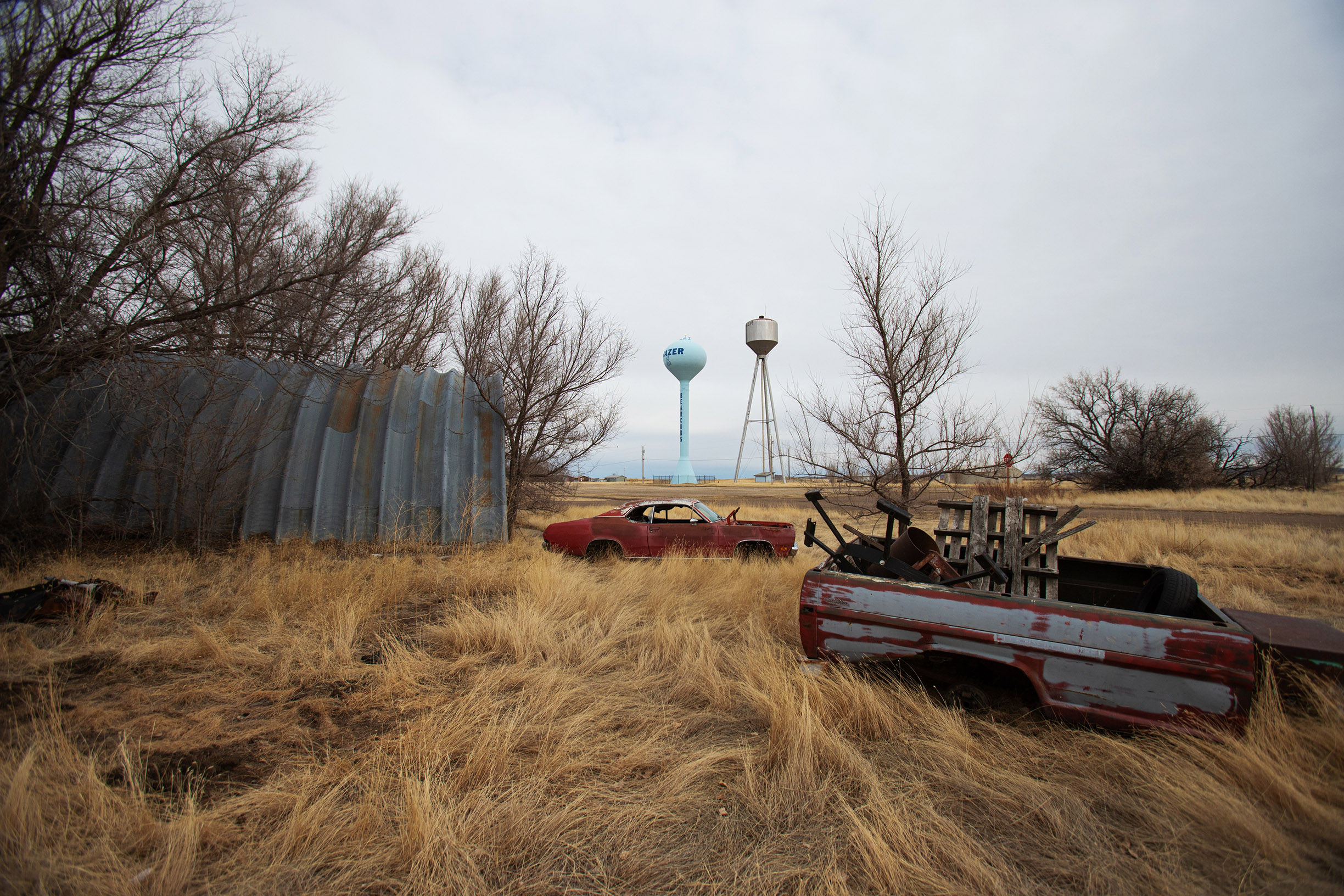
Stopping the Leak
Fixing Frazer’s lagoon could give the town a fresh start
Written by Griffen Smith, Photos by John Paul Edge
The town of Frazer, Montana has a population of less than 400, supporting a public school, elders’ food hall, and two businesses: a convenience store and a bar.
So, when Angie Toce-Blount, who owns the bar, the Beer Mug, planned out her 52nd birthday party, she knew the theme would be ‘80s, with her family and friends — including her sobriety group.
The location was not a challenge to her resolve, but a decision made out of necessity.
Enlarge
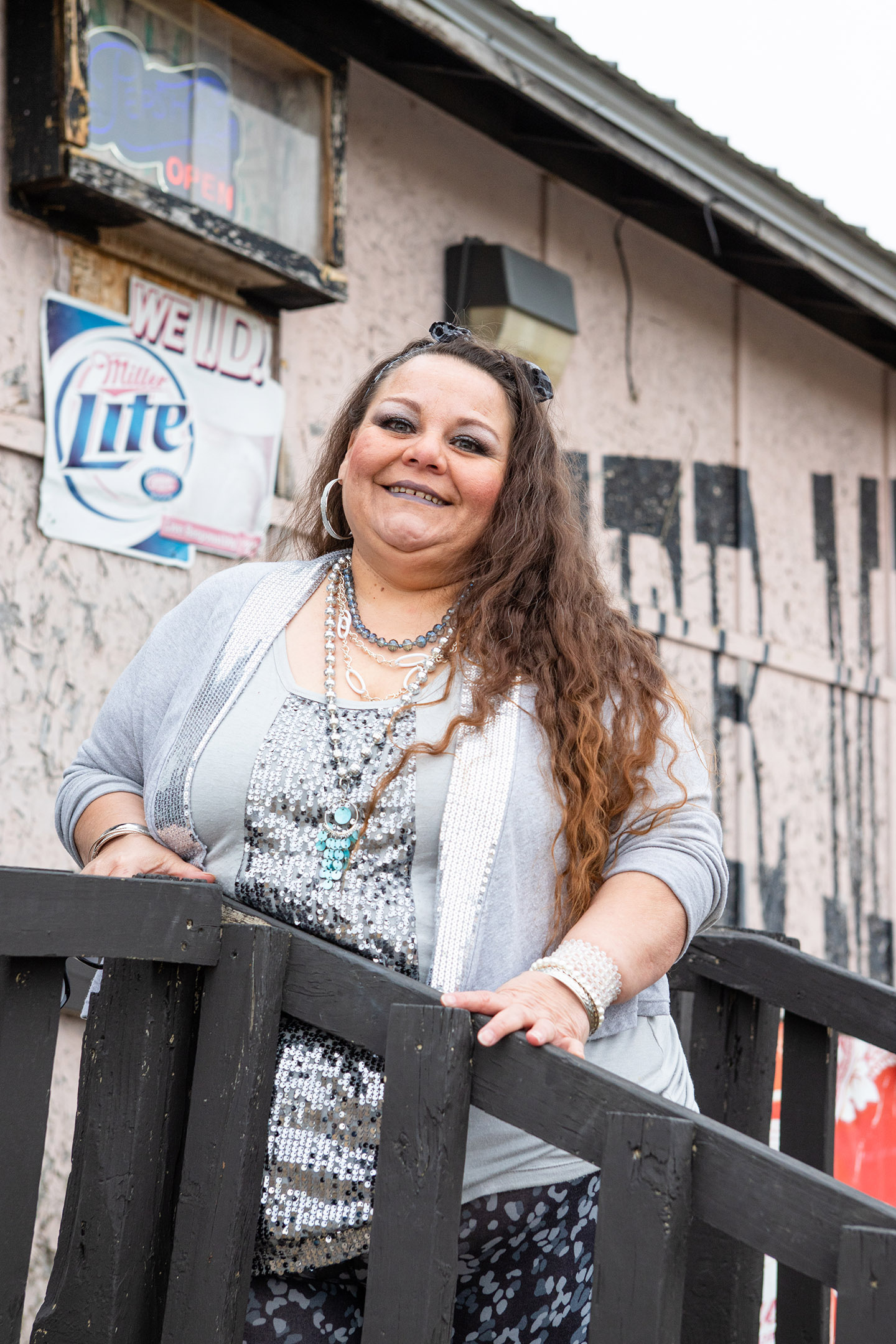
“I’m nervous, this is the first time my medicine brothers will all be together, in a bar of all things,” she said. “In town, it’s the only place to go out, and that is a sad statement.”
Frazer is a small highline town on the Fort Peck Indian Reservation, home to the Assiniboine and Sioux tribes. It sits just out of sight from the meandering Missouri River.
Toce-Blount inherited the Beer Mug from her mom in 1997, when it was being rebuilt. Now, over 20 years since the reconstruction, it is still one of the newest buildings in Frazer, which has long been stunted due to poor infrastructure that has canceled any type of development in the town.
Specifically, there is a 20-year construction moratorium due to a leaking sewer lagoon.
The two water chambers at the end of town have been omnipresent to anyone who has lived there. The lagoon’s legacy, harming both the environment and the town, is in the back of residents’ minds.
“We need help. We need outlets, we need rehab [clinics]. We need a lot of things,” Toce-Blount said. “But if we wait for our tribe or somebody else to do it, we’re going to be waiting another 20 years.”
But then came the pandemic, and a strange hope. With $4 million in funds from the federal CARES Act, Frazer can fix the root of its problem: a leaking, undersized wastewater lagoon.
***
Shirley Flynn first moved onto Joe Butch Street, named after her great grandfather, in 1981. She took a job cooking at the Frazer K-12 school while raising two boys on the east side of town. Back then Flynn recalled a grocery store, a bank, a cafe — anything a person needed was there.
But now, she can barely recognize Frazer. She grew up in town, went to the school and raised a family in her lime green house, which she said is now in need of a new coat.
“Houses have boarded up, people have left, and others go and squat in the abandoned places,” Flynn said as she swept up some brush from her front yard.
As an elder, she has gotten support from the community like food and retirement money. But her husband passed away five years ago from diabetes, and her kids don’t live in town. She does most things at her house, alone, or with her dog Daisy.
“I just live day-to-day,” Flynn said. “I know we are getting a new lagoon, but I think things will take a long time to get better.”
Frazer has shrunk in the last 20 years, dropping from 500 at the turn of the century, to under 400 now. According to the US Census Bureau, Frazer’s average income was $28,036, compared to the national average of $31,133.
Eighty-six percent of adult residents have at least a high school diploma. Many residents leave after they graduate.
Sasha Fourstar was one of them. She enlisted in the U.S. Army in the ‘90s, serving eight years. But she always knew she would return to her hometown of Frazer. Now, Fourstar works as a full-time mechanic for a farm a mile south of town, while also stepping up as Frazer’s mayor, even though she’s never been content with the job.
“Our local elders thought it’d be a good idea to put me in a mayor position, even though I hate politics,” Fourstar said. “But when an Elder asks you to do something, you do it.”
The mayor reactivated the community council 10 years ago, though it has taken occasional short absences. There are three other voting members alongside Fourstar, including Toce-Blount, who is vice chair.
The council has made packages with school supplies, applied for grant funding and planned community spaces, though none of them can be built yet. Without the basic need of new buildings met, Fourstar said her community is struggling.
“It’s a town that’s forgotten; our population is dying,” Fourstar said. “We have a little post office, and a little senior center, and that’s pretty much all we have in town, the rest are homes. We have to drive 30 minutes either way to get anything.”
To compound it all, the COVID-19 pandemic hit the Fort Peck reservation hard. Data compiled from Johns Hopkins University said the virus killed more than 40 and infected at least 900 of the tribes’ 11,700 members.
Toce-Blount estimated more than 80% of Frazer’s 360 people have been infected. Two residents died.
“A lot of these Native American families live pretty close-knit,” Fourstar said. “So once somebody gets COVID, they just kind of spread like wildfire. Wildfire through the families.”
Fort Peck made efforts to contain the virus, from giving students online classes to providing all members buffalo meat from the tribes’ ranch. The most critical support for Frazer, however, was building a quarantine center, which has been all but impossible.
“We were looking to build a quarantine center for Frazer; [COVID-19] was really bad where we needed to quarantine people in multigenerational homes,” said tribal council member Kaci Wallette. “And you can’t even hook into the lagoon anymore because it’s in such bad shape.”
Wallette sits as chair on the tribes’ economic development committee and is also on Gov. Greg Gianforte’s coronavirus response team. For the last year, she and her council members focused on responding to the pandemic.
In the first two weeks of the national emergency, the council received a massive boost in emergency funds. Congress passed the CARES Act on March 27, 2020, a $2.2 trillion bill made to stimulate the economy. Roughly $10 billion was allocated to tribes and its federal agencies.
The Treasury Department gave $2 billion to federal agencies like the Bureau of Indian Affairs, and divided the rest to tribes based on population and federal housing data.
Fort Peck received $29 million from the federal government.
The money, allocated by the Fort Peck Tribal Council, was originally ordered by the U.S. Treasury Department to be spent by the end of 2020. By the time an extension was ordered in December, the tribes had already planned out, and spent, all the money.
Aside from the majority of funding sent in the form of stimulus payments to tribal members, Fort Peck’s largest expenditure was the $4.1 million lagoon project to fix and expand the lagoon in Frazer.
***
In 1967, Frazer invested in a central sewage system, which took all the gray and black wastewater produced from the buildings in town. The pipes all led to a 4-acre, open air lagoon made out of clay and rock 500 feet away from the school and some houses.
Basic lagoons treat water with natural bacterias to eat organic material. After the water is cleared, it can be discharged, depending on the lagoon. But after sealing its discharge pipe in 1993, the lagoon in Frazer holds the water to evaporate.
Tom Daugherty, a licensed lagoon operator and adjunct professor at Gonzaga University, said lagoons have long been the preferred way to treat waste for small, spread out communities.
“They are low cost and high lifetime,” Daugherty said. He has been working to build new state-of-the-art treatment facilities, ones that better process the water.
He said many lagoons built in the ‘60s run on basic clay liners, which he said break down over time. Tina Magnum, a tribal utilities operator who works on the lagoon, said the holding space was supposed to fill up by 2020. As early as 1994, however, the tribe realized something was wrong.
“The only reason the current lagoon still functions is because it leaks,” said Ryan Kopp, head engineer on the project.
Enlarge
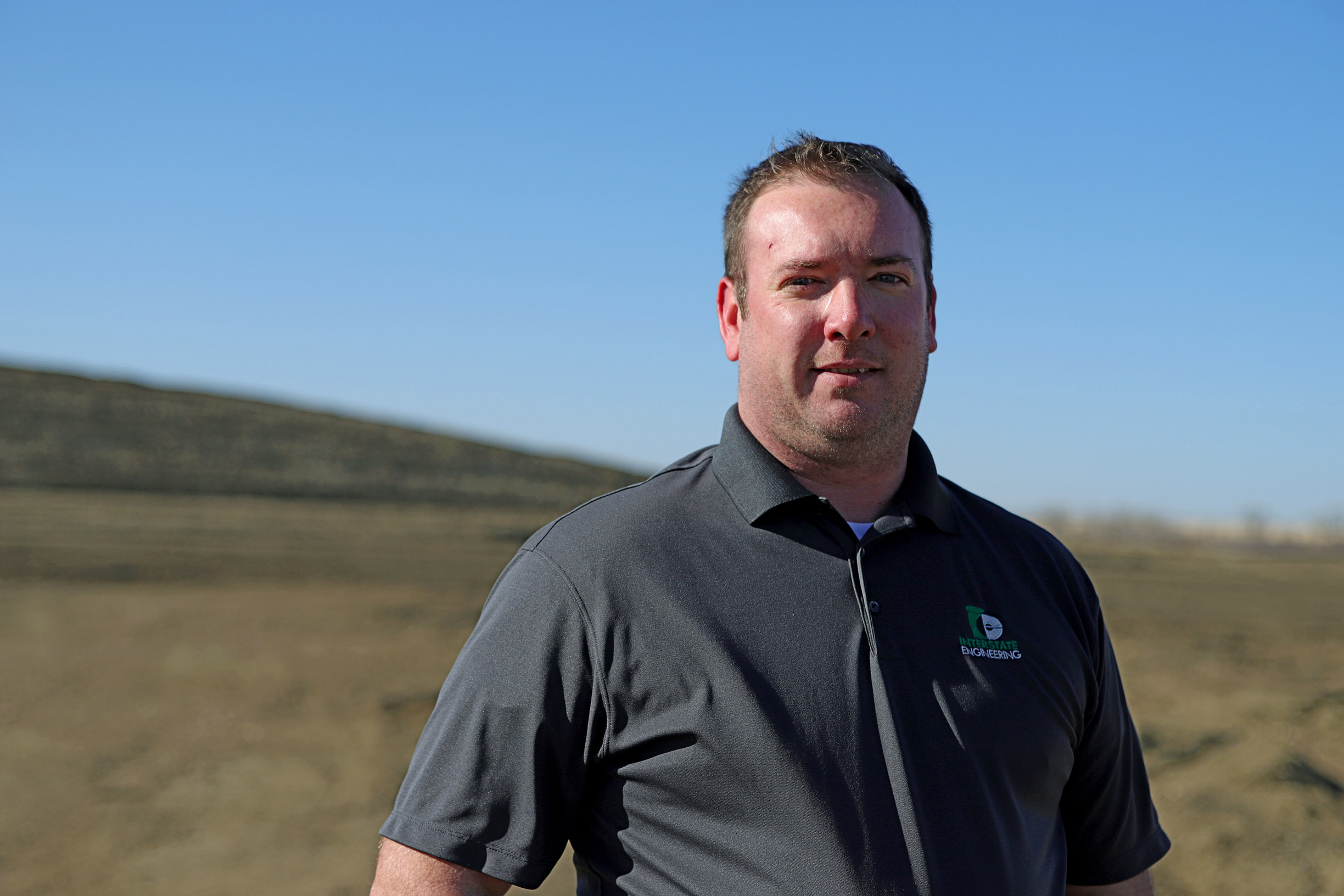
Kopp works at Interstate Engineering, a civil engineering group based in North Dakota. The firm is contracted to handle Fort Peck’s infrastructure projects, and a 2010 engineering report it produced detailed the extent of damage the lagoon was causing.
For at least 20 years, the water has leaked more than 48 gallons per person per day, adding up to over 7 million gallons per year. Kopp attributed it to a weakening of the clay liner.
The leaking water seeps down roughly 80 feet into an aquifer. According to the 2010 report, the leaking water was over 14 times above the acceptable maximum allowed by the Montana Department of Environmental Quality.
The lagoon is also too small to continue to add water flow, which led the tribe to stop all new pipes that would continue to worsen the lagoon. The 2003 building moratorium halted virtually all construction in Frazer, except for a couple houses with separate septic tanks. No more community buildings, except an elders food bank, after school center, post office and the K-12 school, still stand.
Like Frazer, 15% of all wastewater treatment centers in the U.S. have been running at — or over — their original capacity, according to a 2021 report from the American Society of Civil Engineers. The group rated the country’s waste infrastructure as a D+, adding that many wastewater plants have already reached their 40 to 50-year lifespans.
***
Enlarge
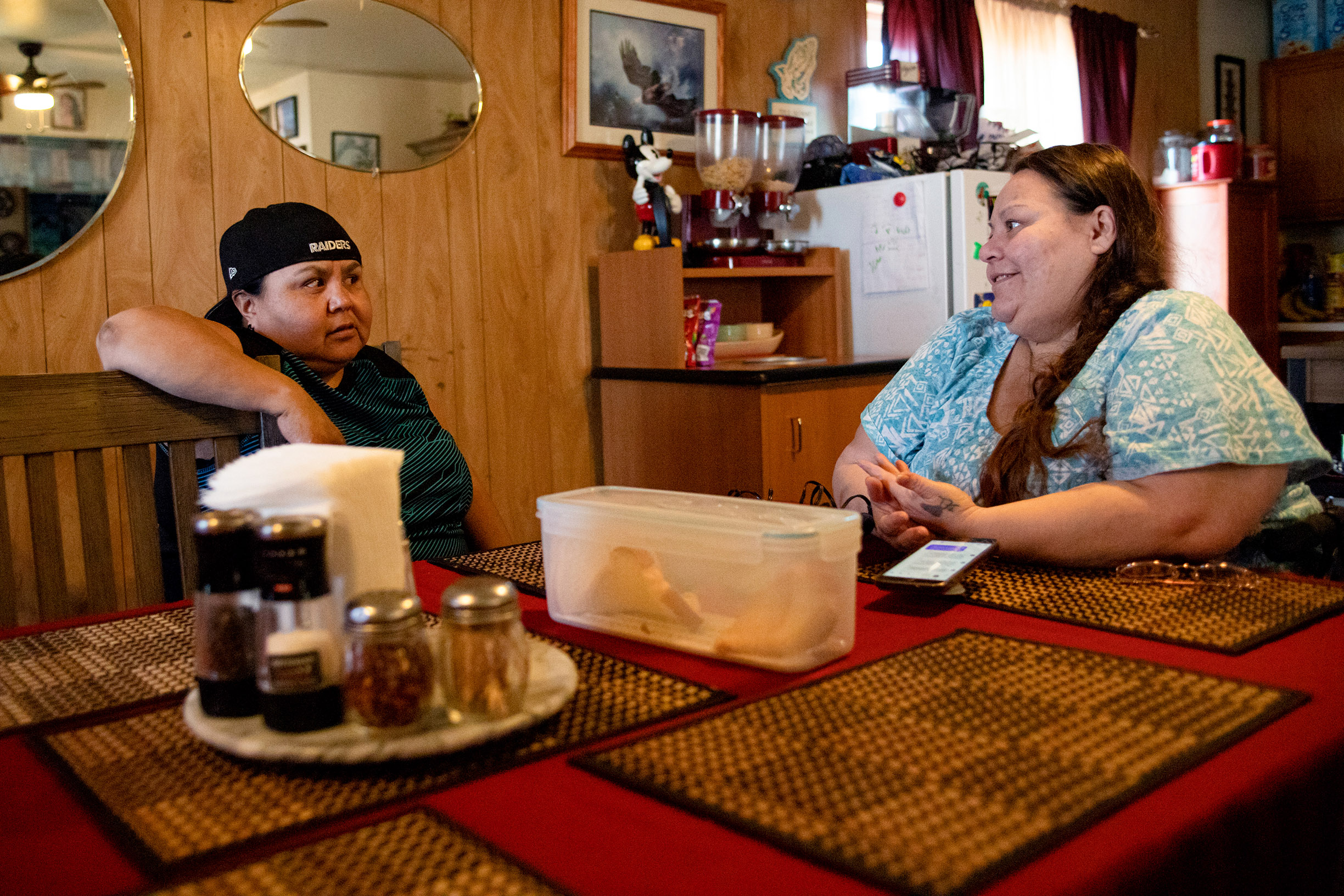
Toce-Blount first got into community service work three years ago, when her brother needed to go to rehab. The two went together. While Toce-Blount never considered alcohol a problem, after a few meetings she realized she struggled with drinking.
“I think I became a new person that day,” she said. “I found God, and I give it all to him for giving me a new start, with new people.”
Toce-Blount has since stepped up in her sobriety group, called Medicine Wheel, driving people to rehab on the reservation. The day before her birthday, she got a call from her Medicine Wheel group asking her to drive two drug addicts to a recovery center in Poplar, 40 minutes away.
“I looked for them, called them, but these ladies were nowhere to be found,” Toce-Blount said. “We need a recovery center here, but we couldn’t build it. Everyone has to be sent to Wolf Point, and that distance matters.”
After she went to her sobriety group, she met and married her wife, Delane Blount. The two foster and adopt kids, more than a dozen in the last few years. Currently, three of Delane’s nieces live with her, and Toce-Blount plans for all of them to graduate high school.
As she prepared her 52nd birthday party, her niece, Alyssa, 16, slowly curled Toce-Blount’s hair. Two of her siblings, Kailiana and Marylyn, helped their aunt by getting flashy jewelry.
“The ‘80s were such a fun time,” Toce-Blount said, putting a layer of blush onto her face. “I had a big liking to rock music, even though they scream a lot.”
“Last strand, auntie,” Alyssa said as she pulled a handheld curler through Toce-Blount’s straight brown hair.
“I’m not that strict of a parent,” Toce-Blount said to the room. “I have expectations for y’all, but I am encouraging. What do I always say, girls? What is your limit?”
“The stars, auntie,” Alyssa responded. Toce-Blount adopted her, alongside her two sisters. Her middle child, Kailiana, spends most of her time making art or biking around town with her sisters.
“You have to do something around here,” Kailiana, 15, said. During the stay at home order, she picked up playing guitar. She and her sisters started a band, and named it The Runaways.
She’s always liked Frazer, but when she graduates high school, she doesn’t plan to stay forever.
“I want to go to New York City,” she said. “There’s just so much out there that I want to see.”
Alyssa hopes to leave the town too. After getting straight A’s in her first two years of high school, she plans to get into Harvard or Stanford.
“I give them tough love,” Toce-Blount said. “They deserve a chance to get out and see the world, and I think they can.”
***
Inside the fence of the lagoon, the sounds of barking dogs and car engines drift through the barbed wire, but no one goes near the water. When the sun touches and heats the stagnant surface, a foul smell permeates Frazer, carried by the whipping plains winds.
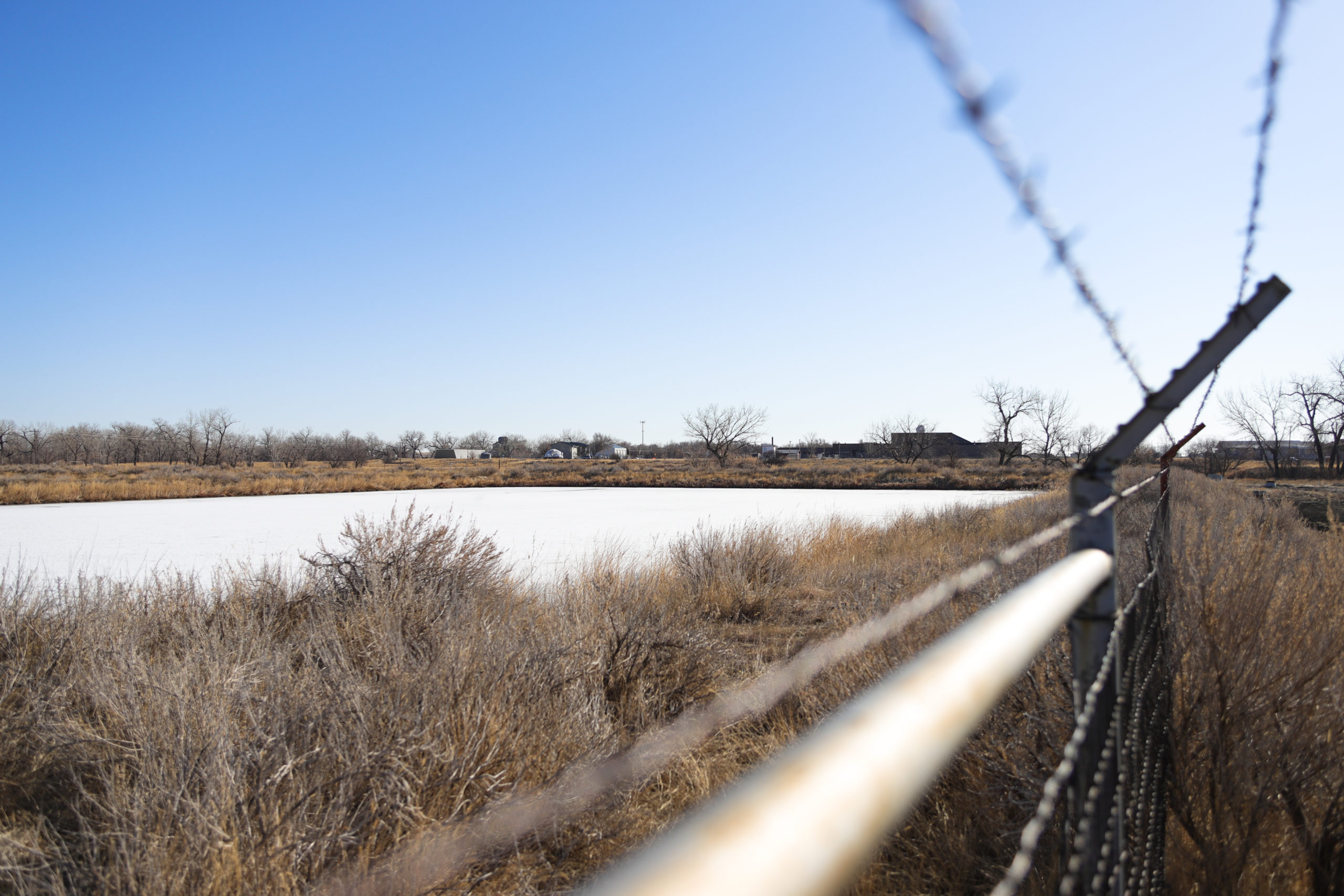
There are five lagoons on the Fort Peck reservation. Frazer was the only lagoon that documented a leak, though all five of the lagoons needed to be expanded. The Indian Health Service, part of the Bureau of Indian Affairs, installed 11 monitoring wells next to the lagoon in 1993.
The tribes were responsible for fixing the lagoon, but had no way to foot the bill of the project. The most likely option was to get grant money from the BIA. But besides some minor maintenance, no action was taken by the Fort Peck tribes or federal agencies.
“We were trying to get funding through IHS before to get the lagoon fixed,” Wallette said. “But stuff just kept falling through.”
The aquifer at Frazer, and even miles downstream, tested high for nitrates. For adults, the chemicals aren’t harmful, but they could cause deadly liver-based diseases, such as methemoglobinemia, for infants and pregnant women.
Since 2007, however, Frazer and the rest of the reservation have been using clean, pumped-in water from a treatment center in Wolf Point, a town 25 miles away. Some residents out of town still use older well systems.
A 2003 capital improvement plan made by the Fort Peck tribes also recommended the Frazer lagoon be expanded five times larger, which would likely cost more than $1 million. The internal report also stated the lagoon was leaking 15 million gallons a year, far higher than Kopp’s 2010 report.
Enlarge
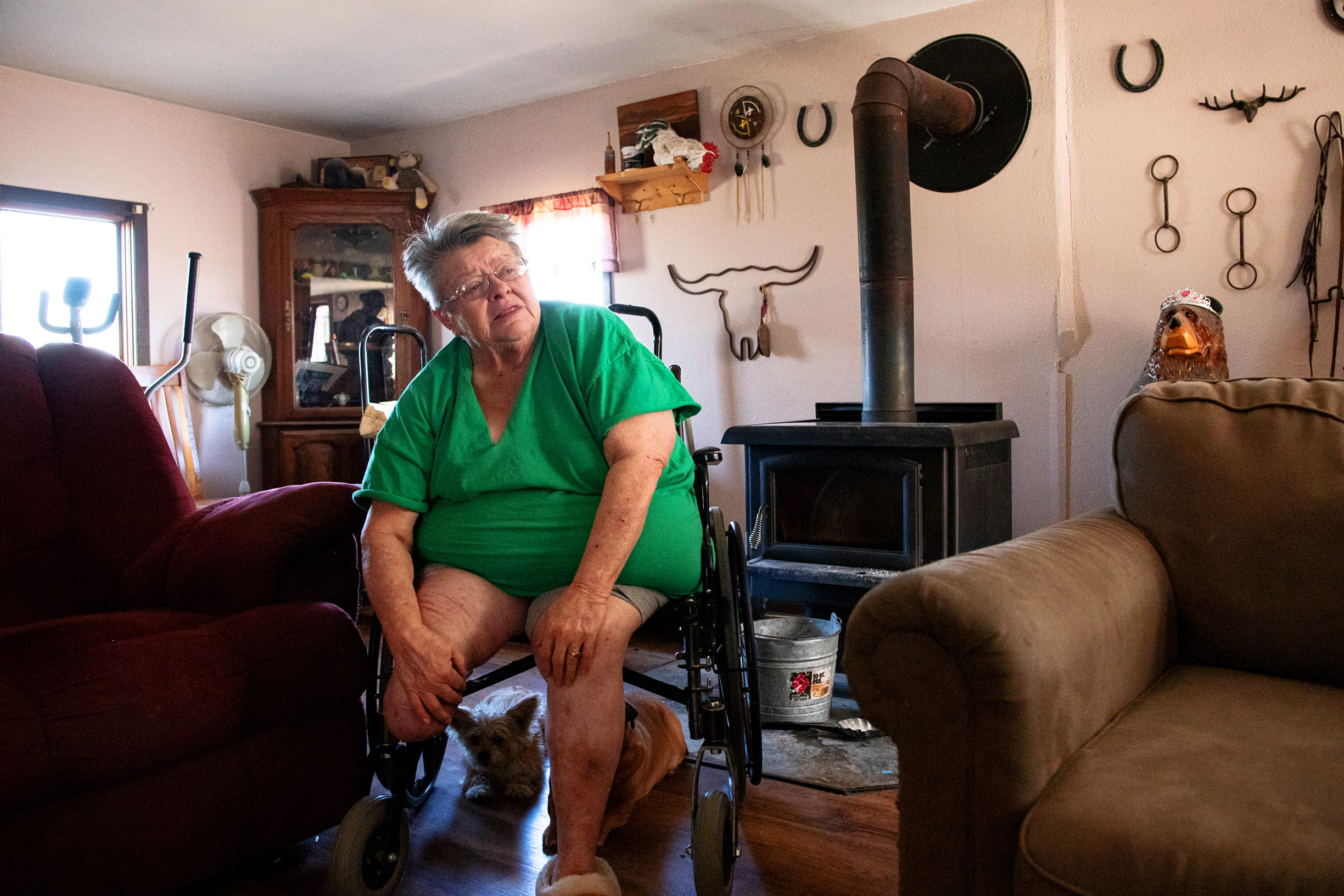
“You smell the stink when it gets windy around here,” resident Agnes Johnston said. “And before they piped in water, you could smell it from the tap.”
As a resident of Frazer for more than 50 years, she watched all her immediate neighbors abandon their homes. Many of the previous residents passed away, but some near Johnston left town for better jobs in Wolf Point or Glasgow, an off-reservation town west of Frazer.
Their houses aged alone, and now most are unlivable. There have been no plans to replace them.
Johnston worked in Poplar, a larger town about an hour away. Each day she commuted from Frazer to the other side of the reservation, often in treacherous winter weather. She said the town has changed: the stagnant state has taken its toll.
“I sit here and think ‘that gas station went first, and then it was the grocery store,’” Johnston recalled. “Most of it burned down or just couldn’t be repaired.”
Yet, with a new lagoon, there is hope. Kopp said the new lagoon will be five times larger than the current one and have a synthetic liner, which is much more reliable than its clay counterpart. In March 2021, Interstate Engineering had already dug six feet down, across five acres south of the lagoon.
“They won’t have to redo their lagoon ever again,” Wallette said. “And the CARES Act has an infrastructure clause. I know other reservations have used the money to redo their roads, or water or water pipes.”
The Blackfeet reservation used its CARES Act money to fund a solid waste program. The Little Shell tribe purchased and renovated a health center exclusively for its own members.
Fort Peck also invested $1 million in a new wellness center in Poplar. Wallette said the tribe has been prioritizing basic infrastructure, as well as community infrastructure, like rehab centers, playgrounds and gyms.
With another stimulus package passed in March, another $31 billion is on its way to tribal governments. In Frazer, Kopp said the next infrastructure project will be installing potable water systems.
“We plan to do more after this lagoon has finished this spring,” Wallette said. “Then we’re going to give Frazer a new quarantine or community center facility. First building in 20 years.”
***
At the Beer Mug bar, Toce-Blount sang ‘80s karaoke from the end of a long table under balloons and lights. From the outside, it is hard to see that the bar is even open. But the inside was recently redone in black and gray, with new seats lining up against the counter.
Anthony Mazawasicuna, Toce-Blount’s biological son, sang along to “Never Gonna Give You Up” by Rick Astley playing on the TV screen. People came in dressed vintage, including Toce-Blount, who wore sparkling satin with a classic headband.
That night, family mingled in and out of the bar. Anthony and his brother Cole played pool on the other side of the single room. Her Medicine Brothers came too; most hopped over from other towns. In that moment, things felt perfect for Toce-Blount.
It won’t be this summer, but in the next year, she might be able to have a birthday in a new community center.
“Starting by the root is where we can grow; we can make this place beautiful,” Toce-Blount said. “The dream of having a cultural center is amazing, and I believe it is going to happen soon.”

Previous
Insecure
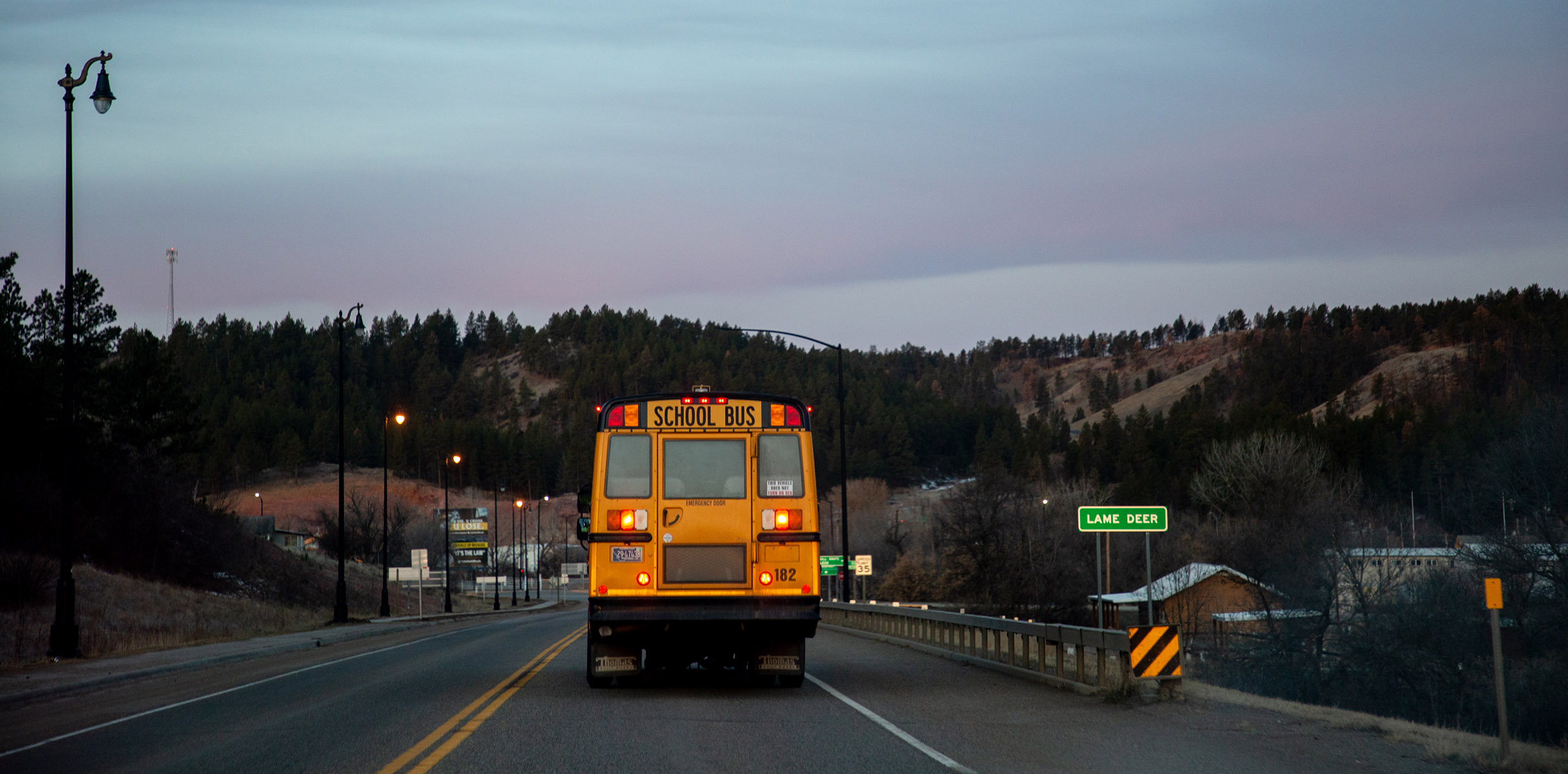
Next